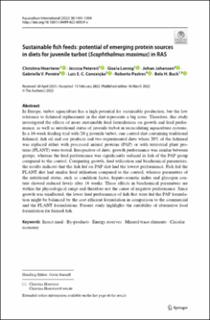| dc.contributor.author | Hoerterer, Christina | |
| dc.contributor.author | Petereit, Jessica | |
| dc.contributor.author | Lannig, Gisela | |
| dc.contributor.author | Johansen, Johan | |
| dc.contributor.author | Pereira, Gabriella V. | |
| dc.contributor.author | Conceição, Luis E. C. | |
| dc.contributor.author | Pastres, Roberto | |
| dc.contributor.author | Buck, Bela H. | |
| dc.date.accessioned | 2022-09-20T18:36:34Z | |
| dc.date.available | 2022-09-20T18:36:34Z | |
| dc.date.created | 2022-04-02T13:36:06Z | |
| dc.date.issued | 2022-03-16 | |
| dc.identifier.citation | Aquaculture International. 2022, 30 (3), 1481-1504. | en_US |
| dc.identifier.issn | 0967-6120 | |
| dc.identifier.uri | https://hdl.handle.net/11250/3020023 | |
| dc.description.abstract | In Europe, turbot aquaculture has a high potential for sustainable production, but the low tolerance to fishmeal replacement in the diet represents a big issue. Therefore, this study investigated the effects of more sustainable feed formulations on growth and feed performance, as well as nutritional status of juvenile turbot in recirculating aquaculture systems. In a 16-week feeding trial with 20 g juvenile turbot, one control diet containing traditional fishmeal, fish oil and soy products and two experimental diets where 20% of the fishmeal was replaced either with processed animal proteins (PAP) or with terrestrial plant proteins (PLANT) were tested. Irrespective of diets, growth performance was similar between groups, whereas the feed performance was significantly reduced in fish of the PAP group compared to the control. Comparing growth, feed utilisation and biochemical parameters, the results indicate that the fish fed on PAP diet had the lowest performance. Fish fed the PLANT diet had similar feed utilisation compared to the control, whereas parameters of the nutritional status, such as condition factor, hepato-somatic index and glycogen content showed reduced levels after 16 weeks. These effects in biochemical parameters are within the physiological range and therefore not the cause of negative performance. Since growth was unaffected, the lower feed performance of fish that were fed the PAP formulation might be balanced by the cost efficient formulation in comparison to the commercial and the PLANT formulations. Present study highlights the suitability of alternative food formulation for farmed fish. | en_US |
| dc.language.iso | eng | en_US |
| dc.publisher | Springer Nature | en_US |
| dc.rights | Navngivelse 4.0 Internasjonal | * |
| dc.rights.uri | http://creativecommons.org/licenses/by/4.0/deed.no | * |
| dc.title | Sustainable fish feeds: potential of emerging protein sources in diets for juvenile turbot (Scophthalmus maximus) in RAS | en_US |
| dc.title.alternative | Sustainable fish feeds: potential of emerging protein sources in diets for juvenile turbot (Scophthalmus maximus) in RAS | en_US |
| dc.type | Peer reviewed | en_US |
| dc.type | Journal article | en_US |
| dc.description.version | publishedVersion | en_US |
| dc.rights.holder | © The Author(s) 2022 | en_US |
| dc.source.pagenumber | 1481-1504 | en_US |
| dc.source.volume | 30 | en_US |
| dc.source.journal | Aquaculture International | en_US |
| dc.source.issue | 3 | en_US |
| dc.identifier.doi | 10.1007/s10499-022-00859-x | |
| dc.identifier.cristin | 2014793 | |
| dc.relation.project | EC/H2020/773330 | en_US |
| cristin.ispublished | true | |
| cristin.fulltext | original | |
| cristin.qualitycode | 1 | |

